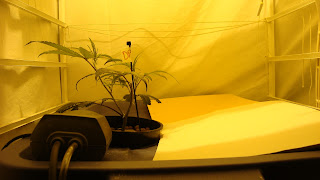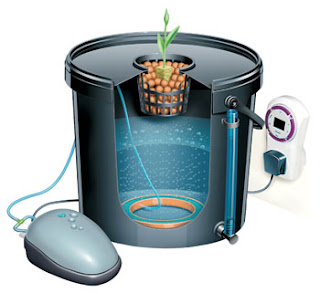January 19: Cut five more clones. Changed water for mother plant, 5 tbs both Grow A and Grow B.
January 20: Clones look healthy. Putting ice cubes in the water of the clone tray to keep it cooler. Mother plant recovering very well.
January 21: Clones are looking good again today. Mother plant is growing back eponentially.
January 22: Clones still look great, continuing to add ice cubes. Mother plant very healthy and is growing fast.
MMJGrowBlog
Saturday, January 22, 2011
Tuesday, January 11, 2011
Make your own DWC Hydro Setup
Thing needed:
10 gallon storage tote
scissers and exacto knife
Aquarium air tubing
Double ported aquarium air pump
2, 6" Aquarium air stones
Net pots from local hydro shop
Hydroton/ hyrdo clay balls/ grow stones
Cut holes in the lid of your tote for net pots. (Two or three). Insert net pots to make sure they fit. Better to cut the holes too small then too big. Next put a small hole in the side of your tote just big enough for your air tubing to fit through. (Make sure the hole is above the water line or is sealed of properly). Attach your air tubing to the two air stones on the inside of your tote. Attach the other ends to the 2 ported air pump. The last step is to fill your netpots up with about a 1/4 inch clay balls or grow stones then instert your 4" rockwool clone or seedling then fill around rockwoool with clay balls or grow stones.
Note:
10 gallon storage tote
scissers and exacto knife
Aquarium air tubing
Double ported aquarium air pump
2, 6" Aquarium air stones
Net pots from local hydro shop
Hydroton/ hyrdo clay balls/ grow stones
Cut holes in the lid of your tote for net pots. (Two or three). Insert net pots to make sure they fit. Better to cut the holes too small then too big. Next put a small hole in the side of your tote just big enough for your air tubing to fit through. (Make sure the hole is above the water line or is sealed of properly). Attach your air tubing to the two air stones on the inside of your tote. Attach the other ends to the 2 ported air pump. The last step is to fill your netpots up with about a 1/4 inch clay balls or grow stones then instert your 4" rockwool clone or seedling then fill around rockwoool with clay balls or grow stones.
Note:
- Storage tote should be opaque in color or painted as such as to not let light into roots.
- If all net pots are not being used fill all the way with clayballs or seal off from light somehow.
Week 2
Monday January 10:
Mother plant has grown significantly. Was topped twice today and the two clones were put in the dome with water at the bottom of tray so they do not dry up. One clone is put into a bubble cloner made from a Gatorade bottle and an air pump.
Tuesday January 11:
Mother plant is in good condition with 5 tops coming in since she has been topped again. Clones look surprisingly healthy. Bubble cloner seems to be working well.
Wednsday January 12: Changed water. 5 tsp Grow A, Grow B.
January 13-18: Out of town. When i retuned there were double the tops and the plant had tripled in size. started soaking clone cubes in water for wendsday.
January 19: Cloned the mother plant five times. and changed the water. 5 tbs plus some spill.
Wednsday January 12: Changed water. 5 tsp Grow A, Grow B.
January 13-18: Out of town. When i retuned there were double the tops and the plant had tripled in size. started soaking clone cubes in water for wendsday.
January 19: Cloned the mother plant five times. and changed the water. 5 tbs plus some spill.
Week 1
Friday: December 31
Durban poison clone purchased from Medical Marijuana of the Rockies. Clone was in healthy condition. Was planted immediately after returning home into the DWC system. Water level: 2-3 cm above bottom of net pot. Grow Nutrients were added a 1/4 strength, PH 5.5-5.8. Shade provided from 400 watt HPS with paper strips. Lights put on 18/6 timer.
Saturday: January 1
No change in plants above ground appearance. No change in plants roots.
Sunday: January 2
No change in plants above ground appearance. No change in plant roots.
Monday: January 3
Woke up this morning around 8 am and was very surprised to find the plant had grown 2-3 inches. And growth in the root base has improved considerably. Roots are now sticking through the bottom of net pot and are suspended into the water.
Tuesday: January 4
6:00 this morning I topped and cloned the Durban Poison.
Clones look healthy and have been misted with 5.5-5.8 ph water.
Mother plant looks very healthy as well.
Wednesday January 5:
Changed water early in the morning 3 tbs grow nute A B. Misted clones . Clones look very healthy so far as well as the mother.
6-9th of January:
Was gone. When returning all clones were dead due to improper misting and cubes drying up.
S.C.R.O.G
When a length of poultry netting is stretched over the grow area, it eliminates the need for conventional training methods. Tying, bending, and crimping are replaced by using the netting as anchors to keep shoots in position. The netting can also be perfectly shaped to make best use of the light. The netting is known as the screen, hence the name Screen Of Green or SCROG for short.
 Plants are topped to promote branching, as the plants grow into the screen and their shoot tips start to grow through the holes in the screen, they are pulled back under the screen and guided to the next hole in the screen to continue their horizontal growth, all the time maintaining the profile of the screen to maximize light use. Growth is extremely robust. While now getting the same light intensity as the primary shoot tips, secondary growth seems to blossom, and from the secondary growth comes tertiary growth, etc., all at the top of the canopy, and all receiving maximum light intensity. How many plants are used depends on how much time the grower wants to take to fill the screen to a point where it will be full with buds at harvest. This will largely depend on the growth traits of the variety he uses, but one can fill a canopy with only one plant if desired. When flowered, only the slow growing buds typical of the post stretch phase are allowed to grow through the holes in the SCROG. The resulting harvest profile is indeed a Sea Of Green but with much fewer plants and the increased yields gained from making use of the void spaces found in a conventionally trained non-SOG canopy.
Plants are topped to promote branching, as the plants grow into the screen and their shoot tips start to grow through the holes in the screen, they are pulled back under the screen and guided to the next hole in the screen to continue their horizontal growth, all the time maintaining the profile of the screen to maximize light use. Growth is extremely robust. While now getting the same light intensity as the primary shoot tips, secondary growth seems to blossom, and from the secondary growth comes tertiary growth, etc., all at the top of the canopy, and all receiving maximum light intensity. How many plants are used depends on how much time the grower wants to take to fill the screen to a point where it will be full with buds at harvest. This will largely depend on the growth traits of the variety he uses, but one can fill a canopy with only one plant if desired. When flowered, only the slow growing buds typical of the post stretch phase are allowed to grow through the holes in the SCROG. The resulting harvest profile is indeed a Sea Of Green but with much fewer plants and the increased yields gained from making use of the void spaces found in a conventionally trained non-SOG canopy.Durban Poison
 Hailing from an unknown garden, Durban Poison is an exclusively inbred South African sativa crossed with a F1 cross. Considered 100% sativa. Typically an outdoor plant due to its ability to grow quite tall with large leaves, Durban Poison can essentially flourish in both inside and out since it does so well under artificial light as well.
Hailing from an unknown garden, Durban Poison is an exclusively inbred South African sativa crossed with a F1 cross. Considered 100% sativa. Typically an outdoor plant due to its ability to grow quite tall with large leaves, Durban Poison can essentially flourish in both inside and out since it does so well under artificial light as well.Durban Poison usually flowers typically after about eight or nine weeks. The buds are long, fat and tight with plenty of resin. These solid nugs are resilient and strong against molds and other diseases, making Durban Poison a strain that can be grown even in non-harvesting seasons making it one of the easier to grow strains available.
The plant produces a Thai-like aniseed smell similar to licorice. A husky, earthy taste pleasant to the smoker. Durban Poison is well known for it's "up" high that produces an energetic, trip effect.
Plant Height: Tall Plant
Stoned or High: High SATIVA
THC Level: High
Flowering Weeks: 8/9
“DWC”
DWC: (Deep Water Culture)
Deep water culture is a system in which the roots of a plant are suspended in a mix of water and nutrient solution that is oxygenated and aerated by an external air pump, that prevents from root rot.
Plants are usually planted in net pots which are filled with soilless medium. Popular mediums include hydroten, Rockwool, and grow stones. In this grow I will be using a combination of mostly hydroten, and a Rockwool cube the plant was cloned into. Net pots are to be suspended above water level about 5cm. However when plants are just starting out and the roots haven't touched the water, you want the level of water to be about 2-3cm above the bottom of the net pot.
Most importantly in this system you want good aeration in the part of the tub or bucket where water is. Lots of bubbles!!! This is probably the most important part of the system, because it prevents the roots from rotting. This can be achieved with a simple aquarium air pump and aquarium tubing both can be purchased for a low cost at your local Wal-Mart or pet store.
Subscribe to:
Comments (Atom)






